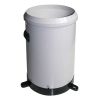KISTERS TB3 Tipping Bucket Rain Gauge
Features
- Long-term stable calibration
- Accuracy not affected by rainfall intensity
- Minimal maintenance required
- Free ground shipping
- Expedited repair and warranty service
- Lifetime technical support
- More
Overview
The KISTERS TB3 is a high-quality tipping bucket rain gauge for measuring rainfall and precipitation in urban and rural locations. Due to the integrated siphon, the gauge delivers high levels of accuracy across a broad range of rainfall intensities.
Reliable Results
The TB3’s tried and proven design ensures long-term, accurate, and repeatable results. It is manufactured from high-quality, durable materials that provide long-term stability in the harshest environments. It consists of a robust powder-coated aluminum enclosure, an aluminum base and stainless steel finger filter and fasteners.
Easy Maintenance
TB3 provides a finger filter that ensures the collector catch area remains unblocked when leaves, bird droppings and other debris find their way into the catch. The TB3’s base incorporates two water outlets at the bottom, allowing water collection and data verification. Maintenance of the TB3 is easy because removal of the outer enclosure and access to the tipping bucket mechanism and finger filter can be done by using the quick-release fasteners.
Dual Output
TB3 includes a dual output 24 VDC reed switch allowing for output redundancy or the addition of a second data logger. The reed switch incorporates varistor protection against surges that may be induced on long, inappropriately shielded signal cables.
| Resolution | 0.1 mm, 0.2 mm, 0.5 mm, 1.0 mm, 0.01 inch |
| Accuracy |
|
| Range | 700 mm per hour |
| Material |
|
| Pivots | Round sapphire pivots with hard stainless steel shaft |
|
Dimensions & Mass |
|
| Environmental Conditions |
|
In The News
Three Decades of Research at Acton Lake
A multi-disciplinary team at Miami University, Ohio, has been studying the environmental change at Acton Lake for over three decades. Using three different NexSens buoys over this time, the team has an incredible archive of data that is helping build a picture of Acton’s past, present, and future. Until recently, a NexSens CB-50 buoy was used alongside other environmental monitoring at Acton Lake. In May 2025, the Miami team deployed a new XB-200 buoy , future-proofing their ongoing monitoring using real-time buoy systems. Acton Lake, a small hypereutrophic reservoir in southwest Ohio, covers 2.4km² and has a maximum depth of about 8m. The dam was built in 1956, and the lake has a large agricultural watershed.
Read MoreSource Water Monitoring in Albany, New York: Tracing Water Quality throughout Tributaries
Thousands of US cities pull their drinking water from natural source waters like reservoirs, rivers, and streams, making overall watershed health a key consideration for water providers. In Albany, New York, the Albany Department of Water and Water Supply delivers drinking water to over 100,000 residents as well as monitors and manages the larger drinking water supply watershed. Hannah Doherty, Environmental Specialist at the Albany Department of Water and Water Supply , spends her days working with a small team to monitor the drinking supply and the connected water bodies. Doherty explains, “We’re the first to encounter the water that ends up being the drinking water.
Read MoreWildfire Prevention in the Sierra Nevada Region with the Yuba Watershed Institute
Though recent wildfires have sparked new conversations about wildfire management and response, groups like the Yuba Watershed Institute have been monitoring the forests and water resources of the Sierra Nevada region for decades, managing approximately 5,000 acres of land with the Bureau of Land Management (BLM) and about 7,000 acres in private land partnerships. The goal of the Institute is to work with local communities and land agencies to improve watershed and forestry management through informed practices and public outreach. The goals of the Yuba Watershed Institute are three-fold: Improve the ability of fire suppression agencies like the California Department of Forestry and Fire Protection ( CAL FIRE ) and the US Forest Service.
Read More
















